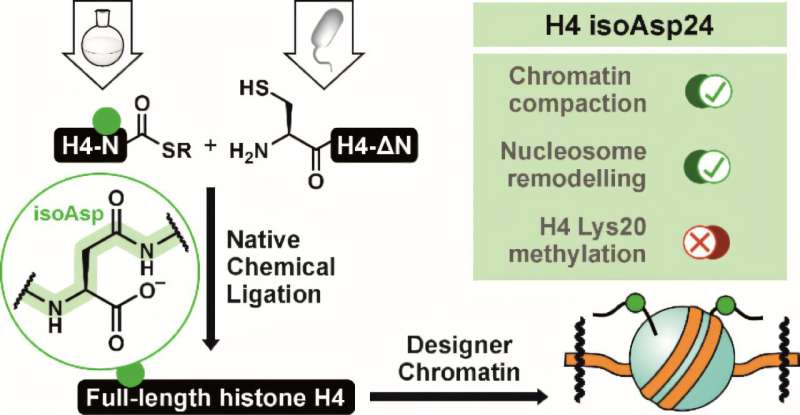Chromatin, the mix of DNA and protein that houses each cell’s genome, is more resilient to aging than previously thought, suggests a study published in the Journal of the American Chemical Society by researchers at King’s College London.
Scientists believe this may reveal how the body can cope with the inevitable “wear-and-tear” of aging and where it may be more vulnerable to its effects, laying the groundwork for future anti-aging treatments throughout the body.
Proteins, much like the rest of the body, change when aging. This is especially the case for the histone proteins that make up chromatin, which may “live” for ~100 days before being replenished and replaced. During their lifetime, proteins are stretched and distorted, or experience processes that are similar to rusting. This damage results in naturally occurring chemical changes to the protein called post-translational modifications, or PTMs.
By changing the physical and chemical structures of a protein, these processes can change their function and even lead them to fail. In some cases, this failure can lead to diseases like cancer but the mechanisms of just how this occurs is often unclear. Furthermore, because natural aging is slow, studying this process within proteins in the body can be difficult.
To uncover the foundations of how proteins experience “wear-and-tear” as they age, the team chemically built chromatin in a test tube at two distinct stages in its lifecycle—recently formed and very old, with the latter containing a PTM associated with aging. At approximately three million daltons, a unit of mass for atomic-scale objects like atoms, the team believe these chromatin models with controlled aging “scars” are the largest of their kind.
They found that aging process had very disparate effects. Despite extreme local changes to the protein brought by aging-related PTMs, the overall structure and integrity of chromatin seemed unaffected. However, enzymes that typically interact with it could no longer recognize these aged regions as chromatin and failed to function.
Dr. Luis Guerra explains, “This was a huge surprise for us. Experiment after experiment showed that chromatin was tolerating quite well the presence of this ‘wear-and-tear.’ But when we zoomed-in and investigated biochemical processes that directly targeted these aged areas that we introduced, we saw massive effects.
“This suggests that chromatin, which sets out the structure of DNA, is more robust than we thought. Think of an old computer. While it may not have the latest graphics card or processor, this modular piece of kit can still surf the web. It might even have a completely fried sound card, but at its core it still functions as a computer. This could mean that the functional integrity of certain parts of the body can be maintained until those faulty parts can be repaired or switched out.”
By chemically building aged biomolecules like proteins and working to identify the ‘tipping point’ of when wear-and-tear irreparably impedes the function of chromatin and other complex cellular components, the team hope to empower future generations of pharmacists to make more effective anti-aging treatments.
More information:
Tianze Zhang et al, Semisynthesis of Isomerized Histone H4 Reveals Robustness and Vulnerability of Chromatin toward Molecular Aging, Journal of the American Chemical Society (2025). DOI: 10.1021/jacs.4c14136
Provided by
King’s College London
Citation:
Complex model of molecular ‘wear-and-tear’ shines light on how proteins age (2025, February 3)
retrieved 3 February 2025
from https://phys.org/news/2025-02-complex-molecular-proteins-age.html
This document is subject to copyright. Apart from any fair dealing for the purpose of private study or research, no
part may be reproduced without the written permission. The content is provided for information purposes only.

